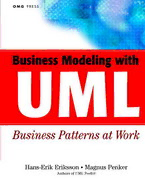Download Business Modeling with UML: Business Patterns at Work PDF Free - Full Version
Download Business Modeling with UML: Business Patterns at Work by Hans-Erik Eriksson, Magnus Penker in PDF format completely FREE. No registration required, no payment needed. Get instant access to this valuable resource on PDFdrive.to!
About Business Modeling with UML: Business Patterns at Work
An introduction to the Unified Model Language, and lessons and examples of practical business applications for software developers.From the authors of UML Toolkit comes a nuts-and-bolts guide for applying UML's vast capabilities to business systems.To perform effective business modeling and develop a successful information system, you need a reliable modeling language that allows you to establish the necessary components and satisfy all of management's concerns. You need UML. With its eagerly anticipated new set of business extensions and techniques, UML is the premiere language for both traditional business modeling and the later stages of analysis and design. Finally, only one modeling language is needed for every phase of project development. This invaluable book, the first of its kind, provides in-depth guidance on business modeling as well as discussions of how patterns, business objects, business rules, CORBA, COM, and Java all fit in to help improve every stage of object-oriented software development.UML (Unified Modeling Language) is a drawing tool to create 'blueprints' for object-oriented systems. It has been officially adopted by the OMG. Think of UML as the AutoCAD of the computer industry. Where AutoCAD is used to create architectural blueprints for buildings, UML is used to diagram blueprints of object-oriented computer systems. Business Modeling is the first phase of software development with UML, in which business concerns are clearly outlined so that an information system with the appropriate Business Objects may be developed.
Detailed Information
| Author: | Hans-Erik Eriksson, Magnus Penker |
|---|---|
| Publication Year: | 2000 |
| ISBN: | 471295515 |
| Pages: | 281 |
| Language: | English |
| File Size: | 3.965 |
| Format: | |
| Price: | FREE |
Safe & Secure Download - No registration required
Why Choose PDFdrive for Your Free Business Modeling with UML: Business Patterns at Work Download?
- 100% Free: No hidden fees or subscriptions required for one book every day.
- No Registration: Immediate access is available without creating accounts for one book every day.
- Safe and Secure: Clean downloads without malware or viruses
- Multiple Formats: PDF, MOBI, Mpub,... optimized for all devices
- Educational Resource: Supporting knowledge sharing and learning
Frequently Asked Questions
Is it really free to download Business Modeling with UML: Business Patterns at Work PDF?
Yes, on https://PDFdrive.to you can download Business Modeling with UML: Business Patterns at Work by Hans-Erik Eriksson, Magnus Penker completely free. We don't require any payment, subscription, or registration to access this PDF file. For 3 books every day.
How can I read Business Modeling with UML: Business Patterns at Work on my mobile device?
After downloading Business Modeling with UML: Business Patterns at Work PDF, you can open it with any PDF reader app on your phone or tablet. We recommend using Adobe Acrobat Reader, Apple Books, or Google Play Books for the best reading experience.
Is this the full version of Business Modeling with UML: Business Patterns at Work?
Yes, this is the complete PDF version of Business Modeling with UML: Business Patterns at Work by Hans-Erik Eriksson, Magnus Penker. You will be able to read the entire content as in the printed version without missing any pages.
Is it legal to download Business Modeling with UML: Business Patterns at Work PDF for free?
https://PDFdrive.to provides links to free educational resources available online. We do not store any files on our servers. Please be aware of copyright laws in your country before downloading.
The materials shared are intended for research, educational, and personal use in accordance with fair use principles.

